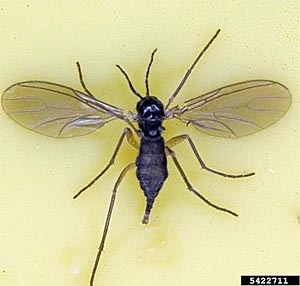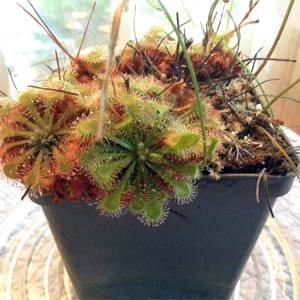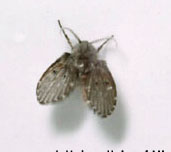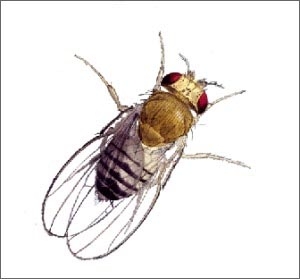Rid Yourself of Nasty Gnats
By Gil Medeiros, Former Fairfax Master Gardener
Fungus gnats, drain flies and fruit flies make up the unholy trinity of flying insects that many of us find in our homes in late fall or early winter. The three are similar in size and appearance, causing many people to think erroneously that these pests are all the same. They are not. They feed and breed in different places in your home, and they are controlled in different ways. They do, however, have a few similarities: All three have short life cycles and can produce as many as five or six generations during the winter months. If left uncontrolled, the fungus gnats and drain flies can multiply into a real headache for the homeowner. Here are some simple and effective methods to control these pests.
Fungus Gnats

Fungus gnat is about 1/8 inch in length. It feeds on decaying organic matter in soil.
If you like to put your houseplants outside for the spring and summer, you probably bring fungus gnats indoors when the houseplants return. Fungus gnats enter as eggs laid in a pot’s soil. They defy the excellent insect-control methods outlined in bringing plants inside. Fungus gnats are annoying little critters that fly around your computer screen and congregate near bright windows, The larval stage of the fungus gnat can nibble on houseplant roots. If the population is not controlled, fungus gnats may damage the roots of small plants or seedlings.
The larvae of fungus gnats thrive in moist soil, where they feed on decaying organic matter. Populations may explode if you have many plants that are regularly watered. Starting seeds indoors and growing new plants from cuttings provide perfect breeding and feeding places for fungus gnats.
Controls
•Dry them out
Fungus gnat larvae live near the surface of the soil. Let the soil in your houseplants dry to a depth of an inch or two between waterings. Adding a one-quarter to one-half inch layer of coarse sand to the surface of the soil in the pots helps this process. The sand dries quickly, and this denies the larvae the moisture they need to survive. Seeds and cuttings need to be continuously moist. Exclude the fungus gnats by covering these containers with clear plastic film used to wrap food.

Staghorn sundew
•Trap them
Sticky card traps work well, particularly if the traps are yellow in color, as yellow attracts the gnats. If you can only find white traps at your local home center, try coloring them with a yellow highlighter to enhance their performance. Cut the cards into small squares, and put them near plants that are infested or on any windowsill where fungus gnats congregate.
I have not had much success with commercial traps filled with proprietary attractant or white wine. These are probably better suited for fruit flies than fungus gnats.
Some carnivorous plants are very effective at attracting and catching fungus gnats. The Sundew staghorn grows long stems covered with many droplets of sticky liquid. The fungus gnats that land on these stems are doomed. Once captured, they become an excellent nitrogen source for the Sundew.

Container of Gnatrol
Feed them something that makes them sick
Bacillis thuringiensis israelenis is a microbial insecticide, very popular in the organic gardening community. It has been thoroughly tested and is safe for use in the home. Mixed with water and added to the soil, Bt is consumed by the fungus gnat larvae, which die in a day or so. Control is achieved by treating the soil with Bt every week or 10 days.
Small containers of Gnatrol are packaged for homeowner use. Gnatrol is a commercial product containing Bt israelensis. Note this is the same strain of Bt that controls mosquitoes; it is not the strain that controls various caterpillars.
Drain Flies

Drain fly is about 1/10 inch in length. It breeds in the slime found in drain pipes and traps in sinks
You will normally find these in your bathroom and sometimes in the kitchen. If you run water in the sink, they will fly out of the drain or the overflow. The larvae feed on the gelatinous bacterial goo that exists in drains. Populations often grow to nuisance levels when the homeowner has been away for a week or more.
Control
Inverted plastic cup is used to cover lavatory drain. Some of the literature advises to clean the drains with a disinfectant and a stiff brush, but in most cases this would require dismantling the plumbing under the sink. I have had success covering the drains when they are not in use. I invert a small plastic cup over the sink drain. This keeps the adult drain flies out of the drains and interrupts the breeding cycle. After a couple of weeks there are no more drain flies.
Fruit Flies

Fruit fly is about 1/8 inch in length. It feeds on rotting or fermenting fruit
These enter the home with overripe fruit. They are serious pests of the food processing and food service industries. In the home, they flit about the fruit bowl and are more of an annoyance than anything else.
Control
Getting rid of fruit flies is simple. Remove and dispose of the overripe or rotting fruit on which they feed and breed. With no place to breed, the population will collapse quickly. Swat any remaining stragglers.
References
Fungus Gnat – Diptera: Sciaridae, VCE Publication 3104-1579
Drain Fly, VCE Entomology Fact Sheets
Fruit Fly, VCE Entomology Fact Sheets
Fungus Gnats, UCDavis.edu
Drain Flies or Moth Flies, ENTFACT-615, UKY.edu